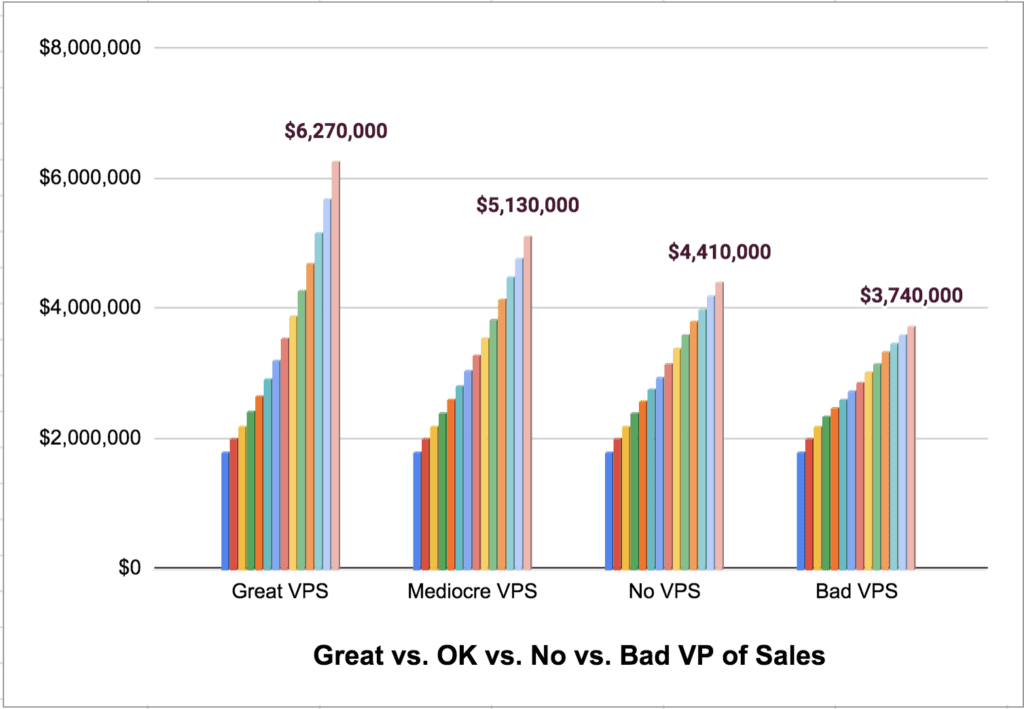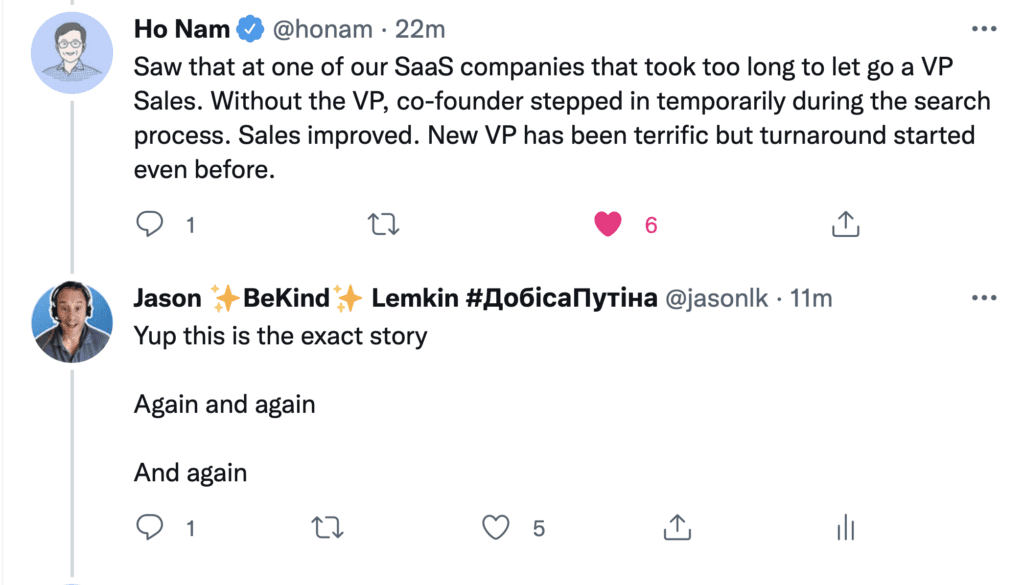You are almost always better off with no VP of Sales than a mediocre one
At first you don't think this is true. You need someone!
But then, sales go down, and burn goes way up
And finally, you see it
— Jason ✨Be Kind✨ Lemkin 🇮🇱 (@jasonlk) November 22, 2023
I wrote a version of this post some time ago, and I think it’s really one of the most important posts on SaaStr of all time, so I wanted to update it, especially in these times of more scrutiny and less capital. Because many of you are wondering … should I let my VP of Sales go?
A debate so many start-ups go through is what to do about a “Just OK” VP of Sales they’ve hired. The VP of Sales turns out to be OK, but great. He or she doesn’t change the game. But they’re not failing either. Things are better than before — just not nearly as good as they could or should be.
How do we define this?
- A Great VP of Sales has an immediate impact and closes much more than before she started. Things accelerate. If not on a month-over-month basis, then at least on a bookings basis. A bit more on that here. Things just get better almost every month and every quarter after you hire her:
- Revenue per lead goes up.
- Quality of rep goes up, or at least, the # of scaled reps goes up.
- Deal size goes up.
- A Good VP of Sales does a bit better than Just Founder-Led Sales in new bookings — but some metrics may get worse. Some things improve, some things go down a bit — but overall, growth is higher than before. Maybe she or he only hired a few better reps, but some are worse than the 2 good ones you hired. Maybe close rates don’t really go up, but deal size does. Or vice-versa. Net net, your bookings keep growing. But perhaps not as fast as they should, given all the folks she’s hired, all the energy going into sales, etc.
- A Mediocre/Bad VP of Sales sees bookings decline. This doesn’t mean they might not succeed in another environment, but at your start-up, he/she is failing. Bookings go down under their watch — often even with far more reps. This is more common than you might think, especially if they struggle to understand the space or product, have never sold at your price point before, or just don’t have enough real start-up experience.
Hopefully, you’ll figure out you hired a “Bad” VP of Sales fast. Like in one sales cycle. Because the “bad” VP of Sales closes even less than you’d close without him, you can pretty much just let him go. More on that here.
And even a Great VP of Sales isn’t great at everything. You don’t have to be patient here, but you may have to backfill, and you may have to get comfortable when she doesn’t do everything you want. For example, she may be great at inside sales, but not as good at mega-deals, so you leave some revenue on the table in the biggest deals (often in exchange for a faster close). Or she may be great at hunting bigger deals, but struggle with the often overwhelming velocity of smaller ones. So Great doesn’t mean great at everything. It just means within one sales cycle, bookings accelerate. And that she hires mostly strong reps.
OK, now the Mediocre/So-So/Pretty Good VP of Sales? Yes, bookings go up under his watch, but more slowly. He struggles to hire all A-tier players … but hires a few pretty good ones. He might never deeply understand the product, but at least gets good at one part of sales. You can see it. He just never gets as good as you at sales overall … but does improve the process and lets you scale. Because as leads grow, as the business grows, it gets too big for the founder to act as the interim VP of Sales anymore.
You can see the difference here as an example in growth rates at $2m ARR over the course of a year from hire, adding $200k in bookings at the time the VP of Sales starts (and you can click on the image to see the assumptions in a Google Sheet);
You can see the problem. If you just fire a truly Bad VP of Sales, things at least go back to where they were before the hire. Maybe not good enough, but usually you rebound fast (internal drama aside).
But if you get rid of the Mediocre, The Good-But-Not-Really-Great VP of Sales … the one that closes more than you used to, but not as much as you know you could … you end up in a tough spot if you don’t have her better replacement at hand. You start to fall behind. Usually very quickly. Because the amount of bookings you used to be able to do before you hired that “OK/Pretty Good/Mediocre” VP of Sales isn’t enough anymore. You fall back to that “No VPS” growth curve above.
You’ll be frustrated with this OK/Pretty Good VP of Sales. But just think and slow it down before you fire him. Are you OK going back in time, to the amount of bookings you closed before you hired him? If not, take a pause. And can you directly manage the sales team without him? Again, if not, take a pause.
A VP of Sales that cost-effectively closes more bookings than you did before is often OK for Now.
So what do you do in this scenario? You’ve thought on it, you’ve looked at the chart above, and you know you can grow faster. You know you need to make some change — but you don’t want to break things. You don’t want to go back in time.
There’s no easy answer, but my suggestions:
- Meet some “Better” VPs of Sales first. Leverage your investors, leverage your network. At least meet 1 or 2 VPs of Sales that, even if you can’t hire them, you’re 100% convinced are an archetype that would help you close more. I.e., first make sure you believe you even know what a “Better” VP of Sales really looks like.
- Come up with a Sourcing Strategy First. How will you find this better VP of Sales? If you don’t know — don’t make any changes yet.
- Once you have a strategy, tell your existing VP of Sales You May Need a “CRO” or “SVP of Sales” to truly scale to $100m ARR — But That You Need and Believe in Her and Want to Keep Her. This can be a tough conversation, but it’s the best alternative once you have a sourcing strategy:
- Tell your existing VP of Sales they have done a very good job, but it’s time to add a more senior boss to take things to the next level.
- Tell him/her that their job isn’t at risk (VPs of Sales will immediately panic, they know it always is).
- And importantly, tell them they’ll be involved in the process of finding this CRO. And importantly — think about telling them the search may not find anyone that is a fit at all, or for quite a while.
- Make sure it’s not seen as a direct demotion. When you do your search, create title headroom. At least try.
- The search may fail. I’ve seen a lot of “replacement” VP of Sales searches fail. If you make your existing VP of Sales part of the process, and make them a stakeholder, things may still be rough. But it gives you some buffer if the search fails. It’s not perfect, but it is something.
In the end, we all want to grow faster. And as the chart above shows, a Great VP of Sales really can make a difference. They just do more with what they have. They close faster, better, and larger deals than a Mediocre VP of Sales does.
But even worse is getting rid of an OK VP of Sales, a Good-But-Not-Great VP of Sales, and being left with nothing. Your business can still compound and grow with a Good-but-Not-Great VP of Sales. And your business may decelerate almost overnight without her. I’ve seen this happen far more often than Firing-and-Hoping-I-Find-Someone-Better working out.



